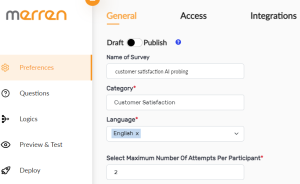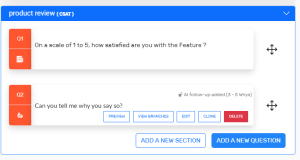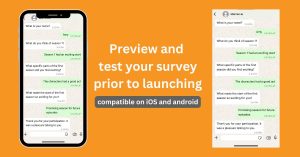Open-ended questions in a survey allows respondents to express thoughts in their own words. On the other hand, closed-ended questions offer predefined or numerical choices. However, surveys that have open-ended questions can probe deeper into responses and uncover unexpected insights.
These questions typically begin with “Why,” “How,” or “What” and invite respondents to share experiences, opinions, and motivations.
✅ Examples of Open Ended Questions:
- Give us the reason for this rating?
- How can we improve your experience with our company?
- What made you choose our product/service?
By allowing respondents to express themselves freely, open-ended questions provide rich qualitative data that can reveal hidden customer pain points, motivations, and emotional triggers.
The challenge with responses on open ended questions
A vague open-ended response is not exactly the data you might be looking for. It can often create problems for researchers:
- Vague & superficial answers: Many respondents give one-word or overly generic answers like “It was good” or “No issues”, making it difficult to extract meaningful insights.
- Irrelevant responses: Sometimes, respondents go off-topic, mentioning things unrelated to the research objective, requiring manual filtering and clarification.
- Incomplete information: Respondents may mention a general opinion (“The product is great”) without explaining why they feel that way.
These challenges limit the effectiveness of open-ended questions, leaving researchers with incomplete, ambiguous, or useless (biased) data.
What is the AI-Powered Question Probing Feature?
AI-driven question probing is a feature from Merren that probes survey-takers on their experiences or purchase decision. This AI creates curated questions that bring detailed qualitative responses. The probing feature creates follow-up questions based on the previous responses to find the root cause of an experience. It follows the 5-step analysis framework (explained ahead).
AI-driven question probing is the solution to create responsive and better open ended questions.
To tackle challenges, AI-driven question probing is transforming how researchers collect and analyze qualitative data. By using intelligent follow-up questions, AI can:
- Clarify vague responses
- Encourage respondent to be more specific or focus on certain aspects of the question
- Keep the conversation relevant to the topic
- Encourage deeper insights without overwhelming respondents
Create AI-Driven Question Probing with Merren: Step By Step Process
Step 1: sign up with Merren for free
Sign-in and add the details of your organization. It will direct you to the main dashboard. Access our pre-designed question forms and survey templates here.
Click on +Create A Survey and then choose “Create from scratch”. Give your survey a name and choose the customer survey category from the drop down list.

Fill in the following details and remember to save the details:
- Survey campaign name
- Survey campaign category
- Maximum number of participants

Step 2: Create questions and survey probing parameters
Choose the preferred metric of question. It helps you create a customized customer satisfaction score (CSAT scale) question. This closed-ended scale has an open-ended response section. Click on edit and access the AI-probing parameter and turn it on.
 AI-probing parameter works on OARS framework
AI-probing parameter works on OARS framework
Merren’s AI-powered survey probing feature follows the OARS framework: open ended , affirmations, reflective listening, summarizing. Choose the OARs framework if you want to get the best out of a customer’s response (especially if the customer has a negative experience. This helps people share the root cause and how it made them feel). The AI-probe will capture genuine interactions that are conversational.

Open ended questions framework:
“Can you tell me more about what made that experience frustrating?”
Merren’s AI initiates the feedback journey with open-ended questions. This gives customers space to describe their experience in their own words, without the restrictions of multiple-choice formats. These types of questions are designed to surface deeper emotions, motivations, and context. By starting with open-ended prompts, we get more nuanced data right from the start.
Affirmations framework:
“That sounds like it took a lot of effort—thank you for sharing.”
Affirmations are key to building trust. When customers feel heard and appreciated, they are more likely to continue sharing experiences honestly. Merren’s AI is trained to respond with empathy, validating the customer’s emotions or effort.
This human-like acknowledgment makes the survey feel less robotic and more like a real, two-way interaction.
Reflective listening framework:
“So, it seems like the delay in service was your main concern.”
Reflective listening is about understanding and restating what the respondent has shared. Merren’s AI uses this technique to show it’s truly listening. It highlights specific parts of the response and gently prompting for more.
This makes customers feel understood and often encourages them to elaborate further.
Summarization framework:
“You’ve mentioned delays, lack of support, and poor product quality. Is that right?”
Before wrapping up the survey, Merren’s AI summarizes what it has learned. This not only helps validate the feedback but also gives customers a chance to correct or add to their responses. Summarization ensures nothing is lost in translation and sharpens the AI’s understanding of customer pain points.
It’s a great way to wrap up the interaction with clarity and confidence.
Step 3: Test the survey to view its AI-driven probing capabilities
Test the question probing feature using Merren’s native WhatsApp survey. Mistakes such as spelling errors or formatting glitches can occur. Ensure that your customer feedback campaign runs smoothly.
On the left side, find the ‘Preview and Test‘ option for your survey. Here, generate a WhatsApp link, which you can copy and share on WhatsApp window.

Step 4: Analyse all customer responses data on the CX dashboard
Click on the analyze tab and get real time reports of all open ended responses. Here what you can do with customer responses:
- View responses on the word cloud data. The word cloud data highlights parts that are the most important for your customers.
- View individual responses and export the sheet for a grid view.
Why Use Merren’s AI-Powered Question Probing?
Deeper insights on customer’s experiences
AI probing goes beyond yes/no or scale-based answers. By asking follow-up questions and encouraging elaboration, it captures detailed stories, emotions, and context from the respondent. This gives brands access to deeper insights that static surveys often miss.
Instead of just knowing that a customer is “dissatisfied,” AI probing captures the why behind a negative experience.
Human-like conversations at scale
With frameworks like OARS, AI mimics natural human dialogue: asking, affirming, reflecting, and summarizing responses. This makes the experience feel less like filling out a form and more like a meaningful interaction, while still being fully automated and scalable.
Increased customer engagement
When customers feel heard and understood, they are more likely to stay engaged till the end of the survey. Affirmative, conversational AI builds trust and rapport, resulting in higher response quality and lower drop-off rates.
Instead of “just another survey,” customers feel like they’re participating in something that values their opinion.
Dynamic follow-up based on context
Unlike static surveys, AI can adapt in real time. It tailors follow-up questions based on what the respondent just said diving deeper where needed and skipping irrelevant areas.
For example, if a customer mentions a delivery issue, the AI might follow up with, “Was the delay longer than expected?” personalizing the flow instantly.
Generate faster insights
AI-powered probing works hand-in-hand with Natural Language Processing (NLP) to analyze open-ended responses. It can instantly categorize them into themes, detect sentiment, and surface key issues. This shortens the time between data collection and decision-making.
What used to take days of siloed data now happens in minutes.
Better decision-making for teams
Deeper and structured insights mean more informed strategies from product tweaks to service improvements to campaign messaging. Teams get not just data, but actionable intelligence. You don’t just know customers are unhappy—you know why, how often, and what to fix first.
Improved customer satisfaction and loyalty
When customers experience a smart, responsive survey and then see changes based on their feedback, it increases trust in the brand. They feel valued, which strengthens brand loyalty and retention.
Do More with Qualitative Surveys Only On Merren CX
Create an account with Merren here and build your own qualitative survey in a few clicks. Merren is an AI-powered customer experience platform that empowers CX leaders and marketing teams to capture customer insights at superfast speed.

